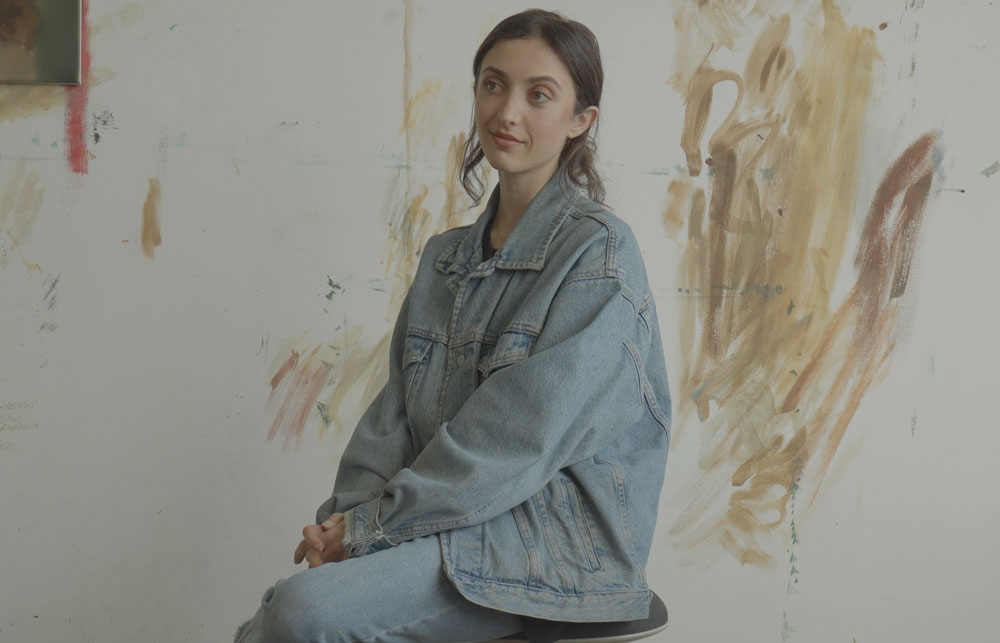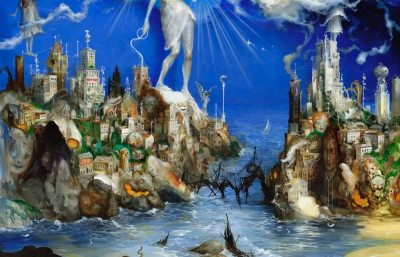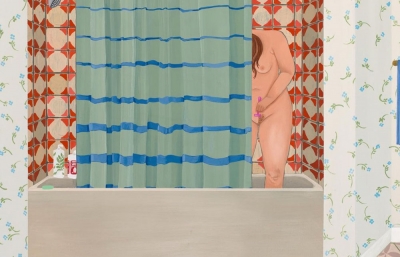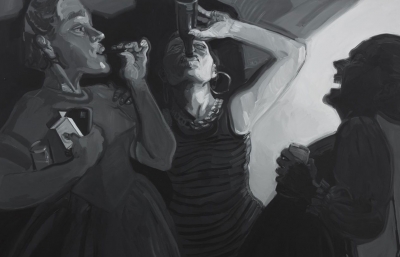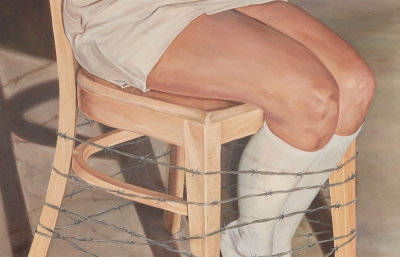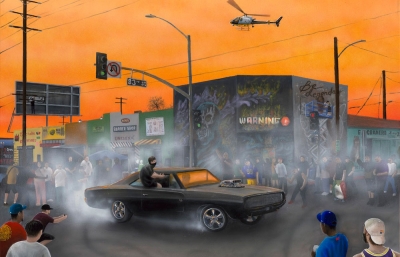Jess Valice
When is a Good Time to Freak Out?
Interview by Charlotte Pyatt // Portrait by Dan Streit
The psychological impact of mass media has fascinated artists and cultural commentators since Marshall McLuhan and the 1960s. While evolving technologies enhance our activities exponentially, they also threaten our ability to consume and process information in a meaningful way as the volume and speed risk desensitizing our normal emotional responses and connection to the world. This ‘cognitive overload' reverberates through the figurative portraits of Jess Valice.
At first glance, there is a timeless quality to the impressive oversized figures, but a closer look reveals something eerily immediate, a familiarity we recognize in her primal landscapes. The focus is almost entirely on the central figure with minimal distractions. Doe-eyed, heavy hooded lids look out beyond the viewer with a melancholic stare that passes right through. While expressions are neutral and their positions still, an emotional presence radiates through a rich palette of mauve skin undertones, emerald green fabric, and burnt amber backgrounds.
With inspiration from various sources, including studies with neuroscience, her journey navigates the weight of expectation, reflecting honesty and vulnerability. As we reach a saturation point, Valice suspends the audience in relatable moments of emotional resonance.
In a world of perpetual coping, when is a good time to freak out?

Charlotte Pyatt: A breakthrough exhibition, Human with Carl Kostyal In London last year and the recent launch of Arrhythmia in Paris with Stems—you’re coming in hot!
Jess Valice: It’s been wild. I took the following year really maturing in my work, slowing down and stepping back to look at each mark more carefully, which is more time-consuming than ever. I find now that I am more present with nature in terms of how things work, how bodies work, with a better understanding of the brevity of life and what that means to me.
I visited the show in Paris and was surprised when you had so noticeably stripped back your compositions, focusing on the presence of your figures. Can you talk a little about your process?
It’s so funny because people take different things from them, some love the icons, and others, the environments. For me, I want to be hybrid in my own way, everyone existing in this liminal space, a nothingness that maybe mirrors the vacancy of expression while flirting with the potentiality of everything and nothing. For this show, I think I was more in touch with myself and my own personality and I’m really excited to continue in this direction. Go deeper without fear toward something more gestural, more primal.
I find your DIY energy, especially as a self-taught artist, really inspiring, and I’m sure other artists do too. Tell us more about how you came to art.
I was studying biopsychology (which is the science of the brain and nervous system and how they influence behavior) and left my studies in pursuit of a career in the arts. Long story short, I started working in an artist studio where I expected to be learning with a brush in my hand. It was actually more of an instructive process on the ecosystem of the art world and the scene. Not only did I learn that being a full-time artist was possible, but the experience also taught me how to be tough enough to endure it.
So I never attended art school, I just read a lot of books. There was an eclectic range of paintings I was drawn to, from the innocent pink-cheeked baroque images of Fragonard to the expressive psychological markings of Bacon. It was fun and easy learning this way. Now that I'm reading about the abstract expressionist movement, I also draw a lot of inspiration from the Renaissance, particularly the expressive nature of the eyes and the pain they radiate. They are never the focus for the narrative but always have such a presence.

There is something poetic about studying the mind and then transitioning to the visual arts. I wonder what influence you feel one has on the other for your practice.
I think that studying the body just made me more curious about people’s minds. It’s all so intricately linked. I think about placing characters in a certain environment and I enjoy observing the assumption that follows, that we know what they are thinking. No one knows where they’ve been, but people use their own experiences to tell or complete the story. I have a lot of fun with that ambiguity. As a neuroscientist, you must be creative, as with all sciences. How we discover anything has to come from someone who is utterly insane. Without insanity, we have no creatives.
The eyes are an unmistakable characteristic of your work. How, if at all, do you consider traditional notions of the gaze?
The gaze now, as it was then, wasn't about sex. Their gaze is more ambiguous, pulling you in, maybe a cry for help, maybe critiquing you. The traditional gaze has more intent and is loaded with the enormity of their experience. My characters are a little more disarming. I want you to stay with them, and them with you… just in the eyes. When I see my figures, usually I cannot place them in any category. I identify them as all me, and all everyone, like some primal unity and coexistence, I’m not sure what that translates to, as we all see what we want to see.
For this interplay between the subconscious and conscious intent, how much of yourself do you think comes through your work?
Probably more than I think. The characters are no one in particular, but parts of me permeate their identity and I find them there on reflection. These puffy swollen faces and heads, it’s how I feel sometimes. I used to wake up with swollen hands and cheeks, that was my experience. These things we see or feel in our bodies and can recognize in others are more important than making everything anatomically correct. I see it in the details too. My dad’s side of the family moved to Detroit from Italy in search of better opportunities and I'm certain that Italian iconography subconsciously filters into my work. For me to feel like I'm portraying them correctly, they need an attitude like they have just witnessed something, been affected by, or committed a crime associated with the mafia or war in general.
Ultimately, I don't think you can remove yourself from your past and you can't chase it; you would be tripping over your own shadow. Unfortunately, it doesn’t stop me from trying! I’m tripping almost every minute. Not doing so is a great mantra that I wish I could live by. Realistically, I have no free will.

On that point, while the work explores a deep focus on the self, how do you feel these themes reflect or engage with our present moment?
There is this overwhelming sense of fatigue that I think is typifying our generation, the weight of a spectrum of emotional responses that digital space provokes in us every day. We have never been more exposed to devastating news stories, politics, war, fighting, and hunger. It’s all so complex—this is where the science and melancholia come in—the recognition of this blankness as a widespread response. It’s too much to feel. I would have a hard time painting someone crying. I don’t want to show you the release… I want to show something else.
This idea of ‘crisis’ I think is so different now, and our methods of consuming information and coping with it are arguably far greater. Imagine 100 years ago hearing about a little button that someone could push that would wipe you out, there would be people screaming in the streets! I'm not sure we know when to freak out now, as we just perpetually cope in heightened states which again is where psychology comes into play. Why isn’t anyone freaking out? As we filter such enormous amounts of terrifying information via our screens, when is a good time to freak out? The figures are more gentle reflections of this intensity, so I want them to stop you and then bother you later. Take a photo and you revisit it to torture yourself, haha, searching for where that familiarity is.
The role of the artist as an agent of change, or a mirror to society, is acknowledged, so how conscious are these notions in your practice?
The other day I was speaking with a musician friend and the conversation was, “What am I supposed to write about?” Our brains are scrambled eggs, so it’s so hard to be in one direction when we are led down a billion paths. AI is the same offering, a new wave of newness. Change is accelerating at such a rate, keeping everyone calm because they feel they are in motion. Feelings of uncertainty and the desire to be stimulated to the point of exhaustion—they are the focus, overwhelmingly so. To not know the right answers is hard as if we cannot access truth. So what does any of it mean? There is so much to worry about, that we forget to worry about ourselves and then it's too late.
I have never considered my work political but I recognize that the work and the anxiety that resonates is impacted by these discussions. For the pressures themselves, I don’t identify specific topics or dates, nor do I isolate them. The primal landscape of my work is relatable but not recognizable by design.

“There is so much to worry about, that we forget to worry about ourselves and then it's too late..”
What’s coming up next?
Next month I have a group show at Almine Rech in Brussels in advance of my solo exhibition with them in 2024, then Art21 with Carl Kostyal in Asia. I'm just really excited about having this time to focus, get back to inventing, and staring at the canvas until I'm ready to make a move.

